eBay Business Model Canvas 2024
While eBay began as a quirky online auction site for collectibles, it has evolved into a global e-commerce giant where millions of users buy and sell everything from everyday items to rare treasures. In this eBay Business Model Canvas, I will identify its customer segments, value proposition, revenue streams, channels, customer relationships, key activities, key resources, key partners, and cost structure.
Interesting fact!
In 2004, a grilled cheese sandwich supposedly bearing the image of the Virgin Mary sold for $28,000 on eBay.
eBay Competitors
Amazon | Alibaba | Walmart | Etsy | Rakuten | Overstock | Newegg | Wayfair | Craigslist | Facebook Marketplace
Customer Segments – eBay Business Model Canvas
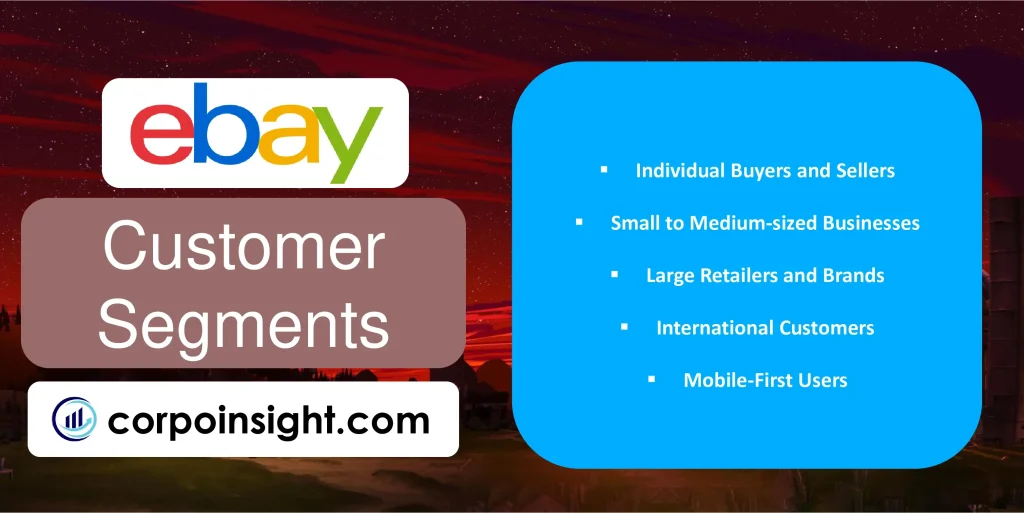
Individual Buyers and Sellers: eBay caters to a vast audience of casual shoppers and sellers, ranging from bargain hunters to collectors, who engage in both new and used item transactions across various categories, including electronics, fashion, and home goods.
Small to Medium-sized Businesses: A significant portion of eBay’s customer base comprises small and medium enterprises that utilize the platform as a primary or secondary sales channel, leveraging eBay’s global reach to expand their market presence and boost revenues.
Large Retailers and Brands: In recent years, eBay has attracted major retailers and established brands who use the platform to liquidate excess inventory, reach new customers, or test market demand for products, thus diversifying the offerings available to consumers.
International Customers: With operations in over 190 markets, eBay has a substantial international customer segment, including buyers seeking unique or cost-effective items from abroad and sellers aiming to tap into global markets, thereby fostering cross-border trade.
Mobile-First Users: As mobile commerce grows, eBay has seen a significant increase in customers who primarily use smartphones for shopping, with mobile accounts for a substantial portion of the company’s gross merchandise volume in recent quarters.
Value Proposition – eBay Business Model Canvas

Global Marketplace Access: eBay provides a vast, borderless marketplace where buyers can access a diverse array of products from around the world, while sellers can reach a global audience of millions, thereby creating unparalleled opportunities for cross-border trade and unique item discovery.
Competitive Pricing and Auction Format: Through its auction-style listings and “Buy It Now” options, eBay offers buyers the chance to find deals and potentially purchase items below retail prices, while sellers can maximize their profits by leveraging market-driven pricing mechanisms.
Trust and Buyer Protection: eBay’s Money Back Guarantee and sophisticated fraud detection systems instill confidence in buyers, ensuring that they can shop with peace of mind, while the platform’s seller protection policies and dispute resolution services safeguard legitimate sellers from potential losses.
Seamless Mobile Experience: With its advanced mobile app and optimized mobile site, eBay delivers a user-friendly experience for on-the-go shoppers and sellers, enabling them to browse, bid, buy, and manage listings effortlessly from their smartphones, which has contributed to significant growth in mobile transactions.
Personalized Shopping Experience: Leveraging AI and machine learning algorithms, eBay offers tailored product recommendations and customized browsing experiences, enhancing user engagement and increasing the likelihood of successful transactions for both buyers and sellers.
Revenue Streams – eBay Business Model Canvas

Transaction Fees: eBay generates a significant portion of its revenue through transaction fees, which include final value fees (a percentage of the total amount of the sale) and insertion fees for listing items, with rates varying based on product categories and seller status.
Advertising Services: eBay’s Promoted Listings program, which allows sellers to boost their item visibility in search results, has become a rapidly growing revenue stream, with the company reporting a 20% year-over-year increase in advertising revenue in recent quarters.
Subscription Services: eBay offers various subscription plans for sellers, such as eBay Stores, which provide additional tools and benefits for a monthly fee, contributing to a stable and recurring revenue stream that has shown consistent growth over the past few years.
Payment Processing: Since transitioning to managed payments, eBay now handles payment processing for most transactions on its platform, earning revenue through payment processing fees while simplifying the buying and selling experience for users.
Value-Added Services: eBay’s portfolio of value-added services, including shipping labels, authentication for luxury items, and data analytics tools for sellers, not only enhances the user experience but also contributes to the company’s diversified revenue streams.
Channels – eBay Business Model Canvas

Mobile Platform: eBay’s mobile app, which has been downloaded over 500 million times, serves as a crucial channel, enabling users to browse, buy, and sell on the go, with mobile transactions accounting for a significant portion of the company’s gross merchandise volume.
Desktop Website: Despite the growth in mobile usage, eBay’s desktop website remains a vital channel, particularly for complex transactions and detailed product research, offering advanced features and a comprehensive user experience that complements the mobile platform.
Social Media Integration: eBay has expanded its reach through social media channels, leveraging platforms like Facebook, Instagram, and Pinterest to drive traffic, engage with customers, and facilitate social commerce, thereby tapping into new audience segments and enhancing brand visibility.
API and Third-Party Integrations: eBay’s open API allows for seamless integration with third-party e-commerce tools, inventory management systems, and multichannel selling platforms, enabling businesses to efficiently manage their eBay presence alongside other sales channels.
Global Shipping Program: This innovative channel simplifies international selling by allowing domestic sellers to ship to a local eBay warehouse, which then handles international logistics, thus expanding eBay’s global reach and facilitating cross-border transactions for sellers of all sizes.
Customer Relationships – eBay Business Model Canvas

Community Building: eBay fosters a strong sense of community through its discussion boards, seller forums, and eBay for Charity program, which has raised over $1 billion for nonprofits, thereby creating a platform where users can connect, share insights, and contribute to causes they care about.
Personalized Customer Support: eBay offers multi-tiered customer support, including AI-powered chatbots for quick queries, specialized teams for high-value sellers, and a recently enhanced resolution center, which aims to resolve buyer-seller disputes more efficiently and maintain trust in the marketplace.
Loyalty Programs: Through initiatives like eBay Bucks and exclusive deals for frequent buyers, eBay cultivates customer loyalty and incentivizes repeat purchases, while also offering programs such as Top Rated Seller status to reward and retain high-performing sellers.
Educational Resources: eBay invests in customer education through its Seller Center, eBay Academy, and various webinars and tutorials, which not only help users maximize their platform experience but also strengthen the relationship between eBay and its user base.
Data-Driven Personalization: Leveraging advanced analytics and machine learning, eBay delivers personalized shopping experiences, tailored email marketing, and customized homepage content, thereby creating a more engaging and relevant interaction for each user based on their preferences and behavior.
Key Activities – eBay Business Model Canvas
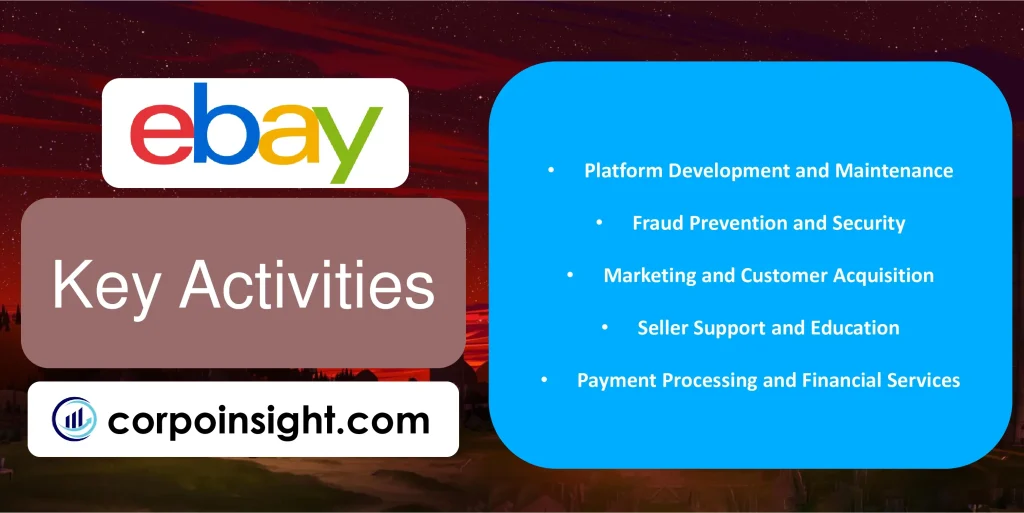
Platform Development and Maintenance: eBay continuously invests in enhancing its technological infrastructure, with a recent focus on AI-driven search algorithms and a more intuitive user interface, ensuring a seamless experience for its 159 million active buyers across desktop and mobile platforms.
Fraud Prevention and Security: To maintain trust in its marketplace, eBay employs sophisticated fraud detection systems and has recently strengthened its authentication services for luxury items, which has led to a significant reduction in counterfeit listings and improved buyer confidence.
Marketing and Customer Acquisition: eBay engages in diverse marketing activities, including targeted digital advertising and brand partnerships, with a recent emphasis on attracting younger demographics through initiatives like its authentication program for sneakers and watches.
Seller Support and Education: eBay prioritizes seller success through comprehensive support programs, including the Seller School launched in 2020, which offers free courses to help sellers optimize their businesses and adapt to changing market conditions.
Payment Processing and Financial Services: Since transitioning to managed payments, eBay has taken on a more active role in payment processing, handling transactions for over 90% of its global marketplace volume, which has streamlined operations and opened new avenues for financial services offerings.
Key Resources – eBay Business Model Canvas
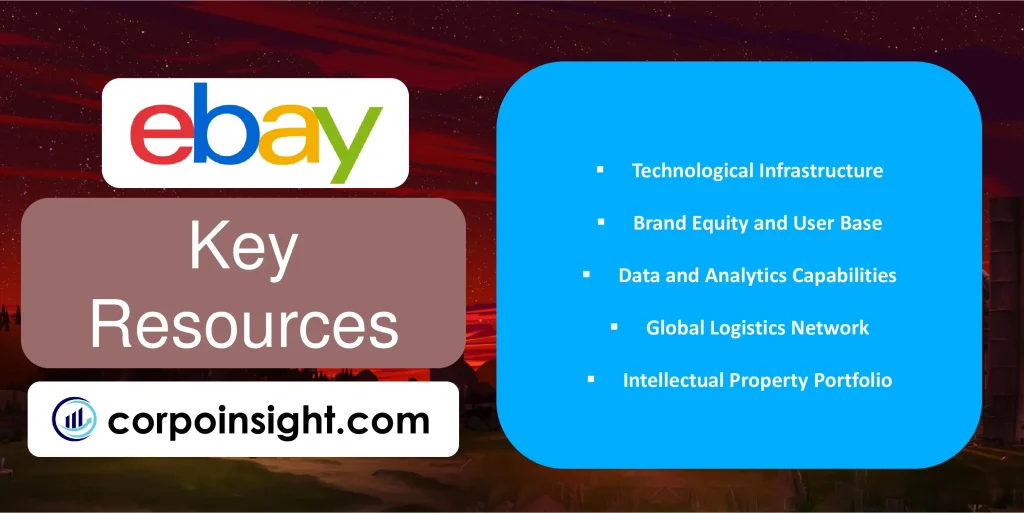
Technological Infrastructure: eBay’s robust technological backbone, which includes advanced AI algorithms, cloud computing capabilities, and scalable platform architecture, enables the company to handle millions of transactions daily while continuously improving user experience and operational efficiency.
Brand Equity and User Base: With over 25 years in the market, eBay’s strong brand recognition and loyal user base of 159 million active buyers across 190 markets serve as crucial resources, providing a solid foundation for growth and innovation in the competitive e-commerce landscape.
Data and Analytics Capabilities: eBay’s vast trove of user data and sophisticated analytics tools allow the company to gain deep insights into consumer behavior, market trends, and pricing dynamics, which inform strategic decisions and enable personalized experiences for buyers and sellers.
Global Logistics Network: eBay’s extensive network of shipping partners and its Global Shipping Program constitute a key resource, facilitating seamless cross-border transactions and enhancing the company’s competitive edge in international e-commerce.
Intellectual Property Portfolio: eBay’s substantial intellectual property assets, including patents related to e-commerce technologies, payment systems, and AI applications, not only protect the company’s innovations but also position it as a leader in marketplace technology development.
Key Partners – eBay Business Model Canvas

Payment Processors: While eBay has transitioned to managed payments, it still partners with major financial institutions and payment providers like PayPal for certain markets, ensuring seamless and secure transactions for users worldwide while expanding its financial service offerings.
Shipping and Logistics Companies: eBay’s collaborations with global shipping giants such as FedEx, UPS, and national postal services not only facilitate efficient delivery but also enable innovative offerings like eBay’s Global Shipping Program, which simplifies international selling for merchants.
Authentication Partners: To combat counterfeiting and build trust, eBay has forged partnerships with authentication services like Authenticity Guarantee for luxury watches and sneakers, which has significantly enhanced buyer confidence and expanded eBay’s presence in high-value markets.
Technology and Cloud Service Providers: eBay’s partnerships with leading tech companies, including a six-year cloud agreement with Microsoft Azure, empower the platform’s AI capabilities, ensure scalability, and drive innovation in areas such as image recognition and natural language processing.
Retail and Brand Collaborations: eBay has strengthened its position through strategic partnerships with major retailers and brands, offering direct-to-consumer options and exclusive collections, which has broadened the platform’s appeal and diversified its product offerings.
Cost Structure – eBay Business Model Canvas
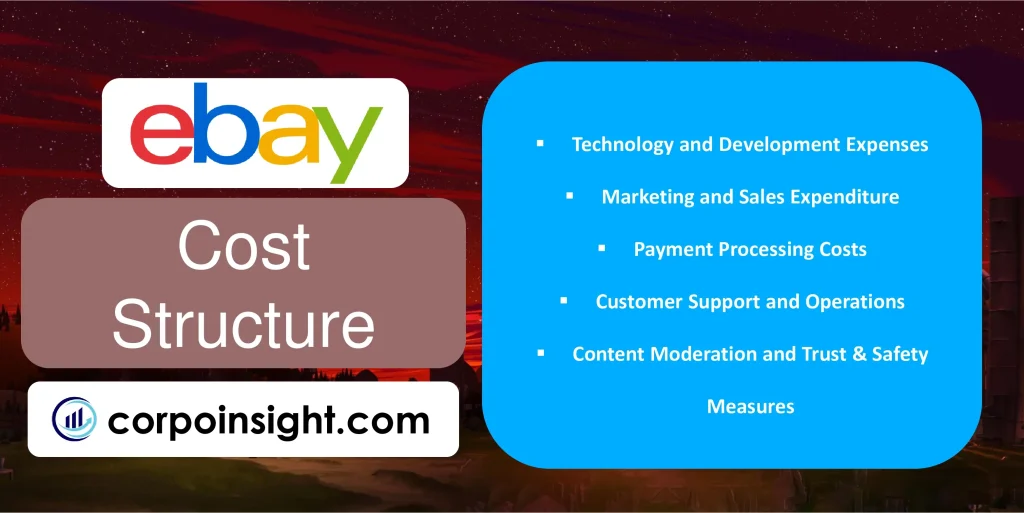
Technology and Development Expenses: eBay invests heavily in its technological infrastructure, with recent financial reports indicating that technology and development costs constitute approximately 20% of net revenues, covering areas such as AI implementation, platform enhancements, and cybersecurity measures.
Marketing and Sales Expenditure: To maintain its competitive edge in the e-commerce landscape, eBay allocates significant resources to marketing and sales activities, which typically account for around 25-30% of net revenues, encompassing digital advertising, brand partnerships, and customer acquisition initiatives.
Payment Processing Costs: Since transitioning to managed payments, eBay has seen an increase in payment processing expenses, which, while contributing to revenue growth, also represent a notable cost factor that scales with transaction volume and impacts the company’s overall financial structure.
Customer Support and Operations: eBay’s commitment to user satisfaction necessitates substantial investment in customer support infrastructure and operational costs, including multilingual support teams, dispute resolution services, and the maintenance of global office locations.
Content Moderation and Trust & Safety Measures: To ensure platform integrity and user trust, eBay allocates considerable resources to content moderation, fraud prevention, and authentication services, with these costs becoming increasingly significant as the company expands into high-value categories and combats sophisticated fraudulent activities.
Summary of eBay Business Model Canvas
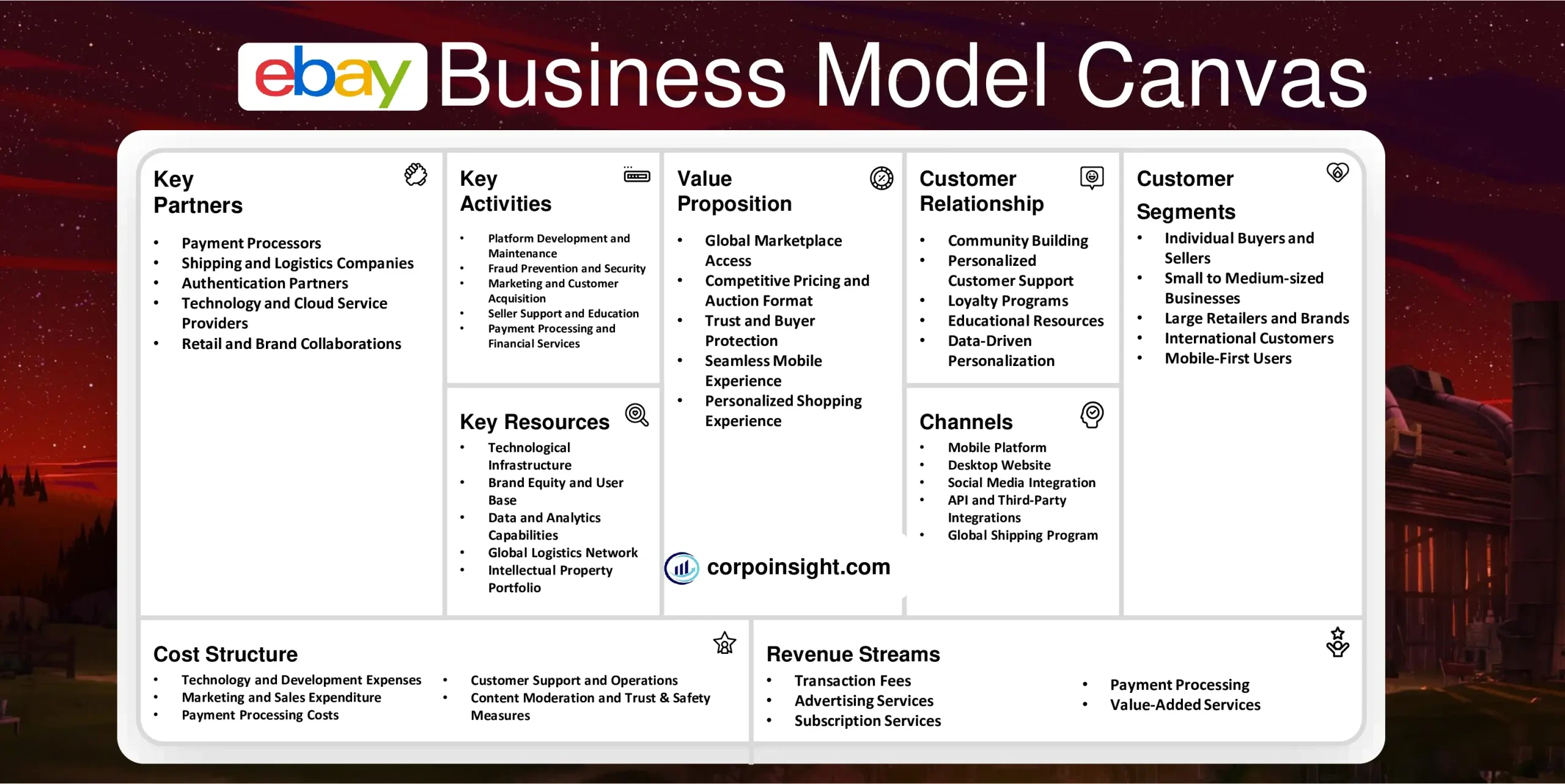
Conclusion on eBay Business Model Canvas
eBay’s Business Model Canvas reveals a robust e-commerce ecosystem built on a global marketplace platform. By leveraging its strong brand, vast user base, and advanced technology, eBay facilitates millions of transactions while continuously innovating to meet evolving market demands. The company’s diverse revenue streams, strategic partnerships, and focus on user trust and experience position it well in the competitive e-commerce landscape. However, eBay must remain agile, addressing challenges such as increased competition and evolving consumer preferences to maintain its market position and drive future growth.

Majoring in marketing from Bangladesh University of Professionals, Sadman Abrar is a learner, obsessed with branding and intrigued to learn about different company strategies, and currently working at bKash.







